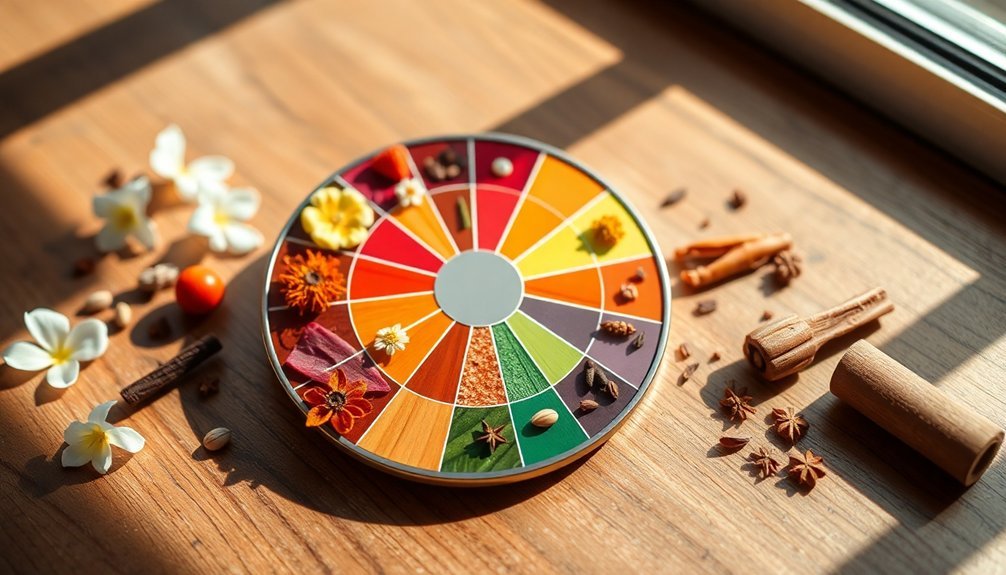The fragrance wheel helps you understand how different scents work together, featuring four main families: Floral, Oriental, Woody, and Fresh. You'll find each fragrance contains three note layers: top notes for first impressions, middle notes for the core scent, and base notes for lasting impact. Adjacent families on the wheel blend well, while opposite sections often complement each other. Master these relationships, and you'll reveal endless possibilities for creating your signature scent combinations.
What Is The Fragrance Wheel And Why It Matters

Whether you're new to fragrances or a seasoned enthusiast, the fragrance wheel serves as an invaluable tool for understanding and exploring the world of scents. This circular diagram, first introduced by Paul Jellinek in 1949, shows how different olfactory groups relate to each other based on their similarities and differences.
You'll find the wheel particularly useful when selecting new fragrances or understanding how scents work together. It organizes cologne profiles into distinct families and subfamilies, making it easier to identify complementary notes and avoid clashing combinations. The structure helps identify scents that appeal to different age groups, as young people prefer sweet and fruity notes.
The wheel's modern version, refined by Michael Edwards in 1992, has become essential for both perfumers and consumers. When you're shopping for fragrances, you can use it to discover new scents by exploring adjacent families that align with your preferences.
The Four Main Fragrance Families Explained
You'll find four distinct fragrance families – Floral, Oriental, Woody, and Fresh – each offering unique characteristics that can blend seamlessly into neighboring families on the wheel.
The Floral family brings powdery and fresh-cut flower notes perfect for spring, while Oriental scents offer rich spices and resins.
Developed by expert Michael Edwards, the wheel helps shoppers and retailers identify scent family similarities more efficiently.
Woody presents earthy forest elements, and Fresh delivers invigorating citrus and aquatic touches.
These families work together beautifully, allowing you to choose scents that match both your personality and the season, whether it's a light floral for summer days or a warm oriental for winter evenings.
Understanding Each Scent Family
When exploring the world of fragrances, understanding the four main scent families – Floral, Oriental, Woody, and Fresh – is essential for finding your perfect signature scent.
Each family offers distinct characteristics and subfamilies that create unique olfactory experiences.
Floral scents showcase sweet, fresh-cut flower notes, while Oriental fragrances feature rich, exotic combinations of spices and vanilla.
Woody scents deliver earthy, grounding elements, and Fresh fragrances offer crisp, clean aromas. The evolution of these fragrance families has given rise to modern scent categories that blend traditional elements with contemporary notes.
To help you navigate these families effectively:
- Start with identifying the main notes you're naturally drawn to (like rose, vanilla, cedar, or bergamot)
- Explore the subfamilies within each category to narrow down your preferences
- Consider the season and occasion when choosing between families (Fresh for summer, Oriental for evening)
Blending Between Family Groups
Building on your knowledge of fragrance families, mastering the art of blending between these groups opens up endless possibilities for creating unique scent combinations.
You'll find that opposite sections on the fragrance wheel often complement each other beautifully, like oriental notes pairing harmoniously with water notes.
To create well-balanced blends, try using the triangle method by selecting three sub-families that form a triangle on the wheel. This technique guarantees your chosen scents work together seamlessly.
You can also experiment with fragrance layering, or "cocktailing," to develop your signature scent combinations.
Start by examining familiar perfumes and their ingredients, then use the wheel to identify matching notes.
Remember that neighboring families, such as Floral and Fresh, naturally blend well together, making them perfect for beginners.
Seasonal Family Characteristics
The world of fragrances divides naturally into four distinct families, each with unique characteristics that shine during different seasons.
Fresh fragrances, with their citrus and aquatic notes, are perfect for hot summer days, while woody scents excel in autumn with their warm, earthy appeal. Floral fragrances bloom in spring, offering delicate, feminine notes that mirror nature's renewal.
For ideal seasonal wear, consider these family characteristics:
- Winter: Amber (Oriental) family provides rich, warm notes of vanilla and spices that cut through cold air.
- Spring/Summer: Fresh and Floral families offer light, invigorating scents ideal for warm weather.
- Fall: Woody family delivers earthy, sophisticated aromas that complement crisp weather.
Each family's unique properties allow you to adapt your fragrance choices throughout the year, enhancing your personal style with the changing seasons.
Understanding Top, Middle, And Base Notes
When you first spray a fragrance, you'll experience the top notes that create your initial impressions and typically fade within an hour.
The middle or heart notes then emerge to build depth and character, lasting several hours while bridging the shift between initial and final scents.
The base notes provide the longest-lasting foundation of the fragrance, offering rich undertones that can persist for days and anchor the entire composition.
First Impressions With Top
Creating lasting impressions starts with a fragrance's top notes – those initial scents that greet your nose within seconds of application.
These volatile notes act as your fragrance's welcoming committee, setting the stage for what's to come while lasting just 10-30 minutes. You'll typically encounter fresh, sharp aromas from ingredients like bergamot, clary sage, and citrus fruits.
When selecting your perfect fragrance, pay attention to these vital first impressions:
- Test the fragrance on your skin, as top notes can react differently with your body chemistry.
- Give the scent time to develop, as top notes quickly blend with middle notes.
- Consider how the initial burst aligns with your desired mood or occasion.
Your top notes will make or break that first impression, so choose wisely to guarantee they complement your style.
Heart Notes Create Depth
Moving beyond the initial burst of top notes, heart notes emerge as the soul of your fragrance, making up 40-80% of the overall scent composition.
These middle notes appear within 15-30 minutes after application and typically last 4-6 hours, creating the true character of your perfume.
You'll discover a rich palette of scents in the heart, from florals like jasmine and rose to warm spices such as cinnamon and cardamom.
Fruity elements like blackberry or herbal touches of rosemary might join sophisticated notes of leather and tobacco.
As they blend with both top and base notes, heart notes serve as the critical bridge in your fragrance's journey.
They retain hints of the opening burst while introducing deeper elements, ensuring your scent maintains its appeal throughout the day.
Base Notes Last Longest
At the heart of every lasting fragrance lies its base notes, which represent 10-25% of the composition and endure far longer than other elements.
These foundational scents emerge after the middle notes fade, creating the final, memorable impression that can last up to 8 hours or more.
Base notes infuse with middle notes to give your fragrance its full body while balancing and softening the overall composition.
You'll find rich ingredients like:
- Woody elements and amber
- Vanillin and coumarin molecules
- Musk, sandalwood, and patchouli
When you're selecting a fragrance, pay special attention to these base notes, as they'll be what lingers longest on your skin.
These deep, persistent aromas define the fragrance's character and create the lasting impression others will remember most about your scent.
How To Identify Kindred Notes On The Wheel
While the fragrance wheel may seem complex at first glance, identifying kindred notes is surprisingly straightforward.
You'll find kindred notes positioned right next to each other on the wheel, sharing similar olfactory characteristics that create natural harmony when combined.
To identify your kindred notes, first locate your primary scent family (Floral, Amber, Woody, or Fresh).
Then, look at the adjacent categories – these are your kindred notes. For example, if you're working with a woody scent, you'll find its kindred notes in the aromatic and amber families.
When you blend these neighboring notes, you'll create a balanced fragrance that flows smoothly from top to base notes.
This simple approach guarantees your fragrance combinations remain cohesive and familiar to the nose.
Mastering Complementary Note Combinations

You'll discover that opposite notes on the fragrance wheel create fascinating combinations when paired together, just like citrus with soft orientals or leather with florals.
By understanding these complementary pairings, you're able to build more dynamic and sophisticated scents that achieve perfect balance.
The magic happens when you match strong contrasting elements, such as amber with ozonic notes or patchouli with citrus, resulting in fragrances that are both intriguing and harmonious.
Opposite Notes Create Magic
Creating magical fragrance combinations begins with understanding the power of opposites. When you work with complementary notes from across the fragrance wheel, you'll discover how contrasting scents can blend into sophisticated and luxurious aromas.
The key is finding notes that are directly opposite each other, like floral and oriental or fresh and woody combinations.
To master complementary note combinations, follow these essential steps:
- Start by identifying opposite sections on the fragrance wheel, such as Floral-Oriental or Fresh-Woody.
- Experiment with known complementary pairs like cucumber water with vetiver.
- Focus on achieving balance between contrasting elements while maintaining harmony.
You'll find that these opposite pairings create depth and intrigue in your fragrances.
Balancing Strong Scent Pairs
Balance serves as the cornerstone when working with strong complementary scent pairs. When you're combining potent fragrances, start with small amounts and gradually build up to achieve the perfect harmony.
Test your chosen scents on separate paper strips first, then hold them together to evaluate their interaction.
To master strong scent combinations, pair oriental notes with amber or vanilla, while woody scents blend naturally with spicy or floral notes.
Remember that citrus top notes create revitalizing combinations with florals, and neroli works beautifully with lavender. For the best results, choose fragrances of similar intensity and quality, particularly from the same brand.
Always test the final combination on your skin before committing, as body chemistry can considerably affect how fragrances interact and develop throughout the day.
Creating Balanced Blends Using The Wheel
When it comes to crafting exceptional fragrances, the scent wheel serves as your essential roadmap for combining complementary notes.
You'll find three powerful techniques to create balanced blends that'll transform your fragrance game.
- Use the neighbor technique to pair adjacent notes, like floral with fruity, for harmonious and familiar combinations.
- Try the opposite technique by matching notes from across the wheel, such as woody with citrus, to create complex, well-balanced scents.
- Explore the triangle technique by combining three subfamilies to develop unique, layered aromas with smooth transitions.
You can master these methods by understanding how different scent families relate to each other.
Common Mistakes To Avoid When Mixing Notes

Despite the allure of fragrance mixing, several common pitfalls can turn your signature scent into an overwhelming mistake. To create successful blends, you'll need to avoid over-application, incompatible combinations, and improper layering techniques.
| Mistake | Impact | Solution |
|---|---|---|
| Over-applying | Overwhelming scent | Spray 6+ inches away |
| Mixing clashing notes | Unpleasant combination | Test on paper first |
| Using dry skin | Poor longevity | Moisturize before applying |
| Incorrect storage | Degraded quality | Store in cool, dark place |
| Random layering | Muddled fragrance | Use complementary notes |
Remember to moisturize with unscented products before application, and don't mix your fragrance with strongly scented body products. When experimenting with new combinations, start with scents from the same brand or family on the fragrance wheel. You'll achieve better results by testing combinations on paper strips before applying them to your skin.
Essential Tools For Fragrance Note Selection
Successfully maneuvering fragrance note selection requires a precise set of tools and techniques.
You'll need a fragrance notes chart to track your preferences and understand how different scents interact. This fundamental tool helps you visualize the relationships between various fragrance families and their subfamilies.
When exploring new scents, rely on these essential tools:
- Single-note fragrances to train your nose and identify pure scent preferences
- Sample sets to test how fragrances react with your skin chemistry
- The fragrance wheel to understand note relationships and make informed combinations
Start with familiar perfumes you already enjoy, analyzing their composition on the wheel.
This approach helps you understand which notes naturally complement each other and prevents costly mistakes when experimenting with new combinations.
Professional Tips For Note Layering

Mastering fragrance note layering elevates your signature scent from pleasant to extraordinary. Start by selecting a balanced base perfume that complements your natural chemistry and has good longevity.
You'll want to apply the strongest concentration first, typically perfume oils or heavy base notes. When layering, focus on creating harmony between top, middle, and base notes.
Apply your fragrances to pulse points, either directly on top of each other or in separate areas to let them mingle naturally. Don't overdo it – one to two spritzes is often enough to evaluate the blend.
Remember to adjust your combinations based on the season and occasion: lighter layers work best for daytime and warmer months, while richer blends suit evening events and winter wear.
Practical Exercises To Train Your Nose
A well-trained nose forms the foundation of fragrance expertise, and you can develop this skill through consistent practice. Start by exploring diverse aromas in your daily environment, from fresh herbs in your kitchen to flowers in your garden.
You'll strengthen your olfactory memory by connecting these scents to personal experiences and emotions.
Keep these essential training exercises in mind:
- Use the fragrance wheel as your guide while testing different scents to understand note classifications.
- Take regular breaks between smelling sessions to prevent nose fatigue.
- Practice with blotter strips to identify the evolution of top, middle, and base notes.
Remember to treat your nose like a muscle that needs regular workouts.
Visit restaurants, gardens, and specialty shops to expose yourself to new aromas, and you'll gradually build a thorough scent library.
Frequently Asked Questions
Can Certain Medical Conditions Affect How We Perceive Fragrance Notes?
Yes, your ability to perceive fragrances can be greatly affected by medical conditions like neurological diseases, nasal polyps, sinus infections, head injuries, and aging. These issues can alter or diminish your smell perception.
How Do Temperature and Humidity Impact the Performance of Fragrance Combinations?
You'll notice your fragrances project more in heat but evaporate faster. High humidity enhances longevity while slowing evaporation. Combined, these factors can intensify some notes while muting others in your fragrance blends.
Are There Cultural Differences in How Fragrance Combinations Are Perceived?
Yes, you'll notice significant cultural variations in fragrance preferences. What's pleasant in one culture may be offensive in another. For example, you'll find light scents preferred in Japan while bold fragrances dominate Middle Eastern tastes.
What Role Does Skin Chemistry Play in Altering Fragrance Wheel Combinations?
Your skin chemistry greatly impacts how fragrances develop. If you've got oily skin, scents last longer and project stronger, while dry skin makes them fade faster. Body temperature and diet also affect fragrance performance.
How Long Should You Wait Between Testing Different Fragrances?
You'll want to wait at least 30 seconds between initial sprays, but limit yourself to testing only 2-3 fragrances per day. Use coffee beans between tests to reset your nose's sensitivity.
In Summary
You're now equipped to navigate the fragrance wheel like a pro. By understanding note families, mastering complementary combinations, and training your nose through practical exercises, you'll create sophisticated scent profiles with confidence. Remember to experiment mindfully, keep track of successful blends, and trust your developing instincts. The fragrance wheel isn't just a guide – it's your key to revealing endless aromatic possibilities.
References
- https://www.candlescience.com/the-fragrance-wheel-notes-families-and-how-to-use-it/
- https://aromaauthority.com/fragrance-notes/
- https://www.alphaaromatics.com/blog/fragrance-wheel/
- https://www.youtube.com/watch?v=KV9Wa9fYx04
- https://en.wikipedia.org/wiki/Fragrance_wheel
- https://chez-pierre.com/blog/fragrance-wheel
- https://reehalmadinah.com/blogs/perfume-blog/the-fragrance-wheel-uncovered-mastering-perfume-classification
- https://www.beautybase.com/blog/2023/03/understanding-the-fragrance-wheel/
- https://byshams.com/en/blogs/how-to-identify-your-fragrance-family
- https://www.fragrancex.com/blog/fragrance-wheel/





Leave a Reply